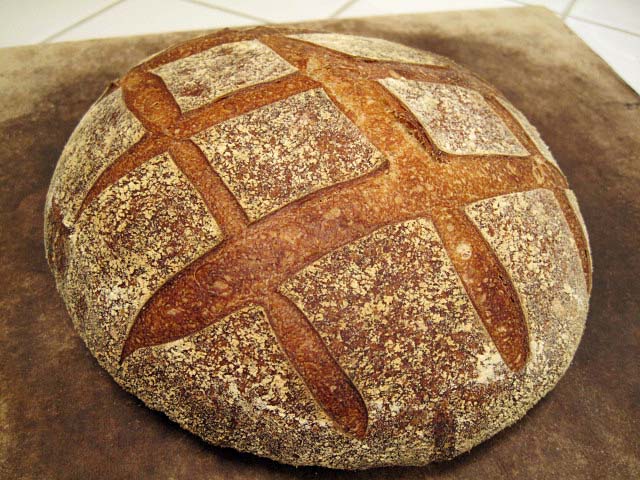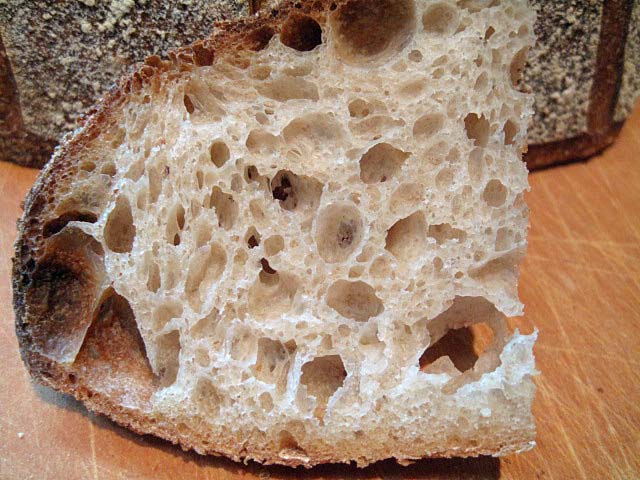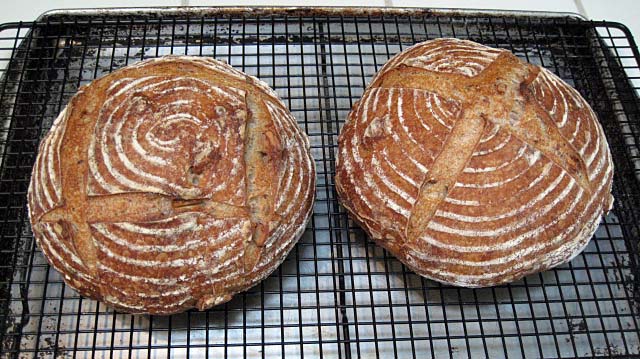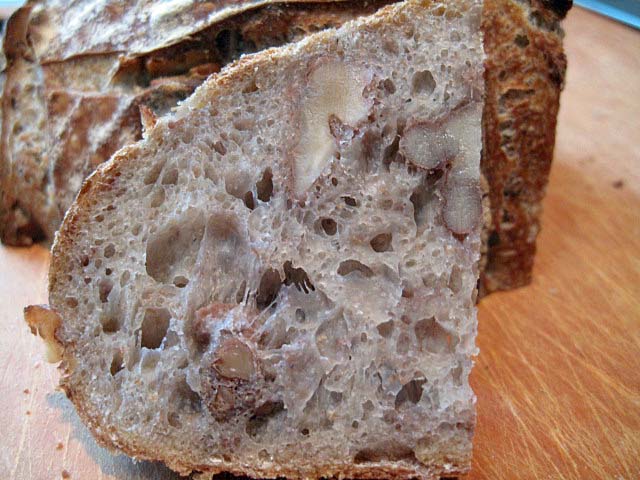
San Francisco-style Sourdough Bread with and without Walnuts
This weekend, I continued trying variations of my San Francisco-style Sourdough Bread. Those who have followed this little adventure will note changes in my starter fermentation, the length of the autolyse and the use of this dough for a Sourdough Walnut Bread.
I started with my stock refrigerated 50% starter that had been fed last weekend. This feeding consisted of 50 g active starter, 100 g water and 200 g starter feeding mix. My starter feeding mix is 70% AP, 20% WW and 10% whole rye flour.
I activated the starter with a feeding of 40 g stock starter, 100 g water and 100 g starter feeding mix. This was fermented at room temperature for 8 hours. The starter was very active. It had tripled in volume and was bubbling. I then mixed the stiff levain.
Stiff levain | Bakers' % | Wt (g) for 1 kg | Wt (g) for 2 kg |
Bread flour | 95 | 78 | 157 |
Medium rye flour | 5 | 4 | 8 |
Water | 50 | 41 | 82 |
Stiff starter | 80 | 66 | 132 |
Total | 230 | 189 | 379 |
Dissolve the starter in the water. Add the flour and mix thoroughly until the flour has been completely incorporated and moistened.
Ferment at room temperature for 12 hours, then refrigerated overnight.
Final dough | Bakers' % | Wt (g) for 1 kg | Wt (g) for 2 kg |
AP flour | 90 | 416 | 832 |
WW Flour | 10 | 46 | 92 |
Water | 73 | 337 | 675 |
Salt | 2.4 | 11 | 22 |
Stiff levain | 41 | 189 | 379 |
Total | 216.4 | 953 | 2000 |
Note: For today's bake, I actually mixed two 1 kg batches of dough. For one, I added about 20% (baker's percentage), or 110 g of lightly toasted walnut pieces. This was mixed at slow speed for a couple minutes after Step 3., below.
Method
In a stand mixer, mix the flour and water at low speed until it forms a shaggy mass.
Cover and autolyse for 20 minutes
Add the salt and levain and mix at low speed for 1-2 minutes, then increase the speed to medium (Speed 2 in a KitchenAid) and mix for 5 minutes. Add flour and water as needed. The dough should be rather slack. It should clean the sides of the bowl but not the bottom.
Transfer to a lightly floured board and do a stretch and fold and form a ball.
Place the dough in a lightly oiled bowl and cover tightly.
Ferment at 76º F for 31/2 to 4 hours with a stretch and fold at 50 and 100 minutes.
Divide the walnut bread dough into two equal pieces. Leave the other dough in one piece.
Pre-shape as rounds and rest, covered, for 10 minutes.
Shape as boules or bâtards and place in bannetons. Place bannetons in plastic bags.
Proof at room temperature (68-70º F) for 1-2 hours.
Cold retard the loaves overnight.
The next morning, proof the loaves at 85º F for 3-4 hours. (If you can't create a moist, 85 degree F environment, at least try to create one warmer than “room temperature.” For this bake, I took two loaves out of the fridge and started proofing them. I took the third loaf out about an hour later and stacked it balanced on top of the other two. I did one bake with the two loaves of walnut bread and a second bake with the third loaf.)
45-60 minutes before baking, pre-heat the oven to 500º F with a baking stone and steaming apparatus in place.
Transfer the loaves to a peel. Score the loaves as desired, turn down the oven to 460º F for the smaller loaves or 450ºF for the larger one, steam the oven, and transfer the loaves to the baking stone.
After 15 minutes, remove the steaming apparatus, and turn down the oven to 430º F/Convection. (If you don't have a convection oven, leave the temperature at 460º F.)
Bake for another 15 minutes for the smaller loaves or 25 minutes for the larger loaf.
Turn off the oven, and leave the loaves on the stone, with the oven door ajar, for another 15 minutes.
Transfer the loaves to a cooling rack, and cool thoroughly before slicing.
One of my personal objectives in making this bread for so many weeks running has been, first of all, to develop a formula and procedures that produce a particular style of bread, and secondly to see if I could make small changes that accommodate to my other needs without changing the end product too much.


The bread without walnuts was very similar to the last San Francisco-style Sourdough Bread I had baked. The crust was crunchy and nutty-flavored. The crumb was chewy-tender with a moderate sourdough tang and excellent, balanced flavor.


The bread with walnuts was just delicious. I love the flavor of toasted walnuts in sourdough bread. I don't know why I had waited so long to make it again.
Tonight we'll have an appetizer of sourdough walnut bread with an interesting Spanish goat cheese followed by roasted herbed chicken/gruyere panini and a green salad.
David
- dmsnyder's Blog
- Log in or register to post comments
David,
I have enjoyed reading your adventures with this loaf and will be interested to hear the overall end results after you have reached a singular conclusion - if such a thing does exist in the bread world :-) I know I keep tweaking 'just to see' what will result - drives the family nuts!
I would imagine that the walnuts in the loaf really change the flavor - especially when roasted. I hesitated adding walnuts to any of my loaves for a long time because whenever I eat them I get a sore mouth from something in them so I kind gave up until I found a recipe that combined apples, cranberries and walnuts.....my daughter was instantly hooked. In fact, yesterday I made a loaf plus some rolls but with walnuts and cranberries only that she took to her ballet class to share with her buddies ....nothing came home except empty bags.....methinks they liked the combo too :-)
Your loaves look great - I am impressed as always by your scoring. Always looks so precise and uniform.
Take Care,
Janet
I've made a pecan/dried sour cherry loaf that was popular on TFL a few years ago. Versions can be found here, on SusanFNP's Wild Yeast Blog and on SteveB's Breadcetera.com. Some substituted dried cranberries for the cherries. I also made a Walnut-Raisin sourdough at SFBI, and I think I posted the formula on TFL. It was a particular favorite of brother Glenn's.
I bet you would enjoy any of these variations, from what you say.
David
Hi David,
I just checked out both of these loaves and they look like ones that my daughter would love so both have be added to my 'to bake' list. Thanks for the suggestions and pointing me in the right direction :-)
Take Care,
Janet
This looks scrumptious, David. Absolutely. Probably stellar with anything, but I can image an exotic goat cheese is the perfect match.
I wonder how your SF sourdough tales will be documented in the end, David? Do you plan on following the academic route and presenting your studies in a series of letters, or are you more inclined towards writing a personal travelogue, where stories from the sourdough quest is mixed with your thoughts on culture, history, religion and the meaning of it all? :-)
Wonderful looking bread, David, and as always very inspiring. Have a nice week!
My "Sourdough Tales" are currently being published as a weekly serialized column on an outstanding web site. This one! By virtue of your TFL membership, you have been given a subscription at no extra charge.
Back issues can be found by using the TFL search box and entering "dmsnyder's blog."
Negotiations for re-publication in The Journal of Irreproducible Results are ongoing.
As far as "the meaning of it all" goes, I have been given to understand that the answer is 42. There is nothing more to be said.
David
;-)
So no plans for a Hemingway-ian "The old man West Coast baker and the sea sourdough" short story, David? Many possibilities here: "For whom the sourdough loaf sings", "A farewell to bland white bread" etc. I think many of us loafers would love a semi-autobiographical travelogue :-)
As for the meaning of life: I always thought PI would have something to do with it, but my mistake. ***I'll go into the corner and try to keep quiet for a while***
You've only just re-emerged Hans, don't hide in the corner so soon please!
Andy
Negotiations for re-publication in The Journal of Irreproducible Results are ongoing.
As far as "the meaning of it all" goes, I have been given to understand that the answer is 42. There is nothing more to be said.
That's hilarious, David.
what not to love in that flavor combination...beautiful bake! @ Hans, great to have back, you been missed!
Sylvia
The walnut bread gets toasted and spread with almond butter for breakfast. That should be something else.
David
...to the bread, the walnuts, the menu, everything.
:^) breadsong
David
Great post, as usual, David!
One question: when you build the stiff levain, you mention a "stiff starter". But above, when you describe the way you activate your starter, you use 40 of stiff stock starter, 100g water and 100g (mixed) flour: that is ~ 89% hydration. From this starter you took the given amount to build the stiff levain, have I understood correctly?
thanx, codruta
David
Beautiful crumb on both loaves, David. Wish I could taste them.....;)
David
and the one with walnuts seems just as lofty as the one without, which seems like an achievement to me. Really beautiful breads. -Varda
David
Hi David,
Have you now arrived at the point where you no longer feel the need to make any changes?
Both these varieties look particularly special
Best wishes
Andy
Thanks for the compliment!
Yes. I think no further changes are necessary. This bake answered most of my remaining questions about what I could change without significantly changing the flavor of the bread. Of course, there is always "just one more tweak" to test, but that's not "needed." Most important to me is that I am convinced that I can reliably produce this same bread again and again, if I follow my procedures.
The ingredients are set, although I really do want to try this bread at lower hydration.
I am convinced that the two starter feedings before the final mix, going from stock firm starter to liquid activated starter to firm levain, results in a balance of yeast and LB that does a good job with both levening and flavor development.
I think the levain can be retarded or not. What's important - for flavor, not just leavening power - is that it be well-matured before mixing in the final dough.
The other particulars are applicable to any lean hearth bread.
David
Can this be made with a higher-hydration starter?
I usually take a 1/4 of starter and feed it with 1/2 cup water and 2/3 cup flour.
Hello David, despite many challenges I was finally able to try your recipe. I enjoyed the flavour even though aesthetically it looked different. I'm baking at almost 6000 feet and the flour had to be sourced from the UK. It's impossible to do many trials because of that. I'm curious to know what Protein content flour you use as mine was 13% stoneground unbleached organic. Regards, Peter S in Nairobi.